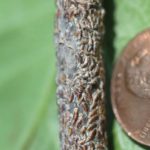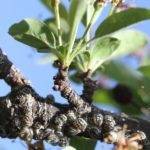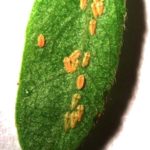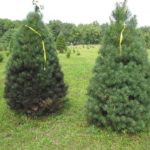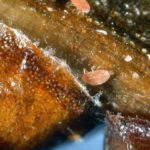Scale insects appear to be designed to avoid exposure to insecticides. Fortunately, these pests are often kept under control by a wide range of natural enemies. Successful management of these pests depend on helping these natural enemies thrive, while making it difficult for scale insects to grow and reproduce.
What are scales insects?
Scales are sucking insects that are closely related to aphids and mealybugs. They live most of their lives glued to a branch or leaf so they can drill a wire like straw into the plant so they can suck out and feed on plant juices. Armored scales cover themselves in a dry waxy armor and live most of their lives on a twig (Figure 1) or leaf (Figure 2). In contrast, soft scales are sticky to the touch and most spend the winter and spring on twigs (Figure 3) and summer on leaves (Figure 4). Soft scales are sticky because they are covered with liquid excrement that eventually turns black with a mold that can turn a plant black and reduce its capacity to grow and survive (Figure 5). Each scale insect lays large numbers of eggs under their shells (Figure 6) that hatch into a crawling stage that walks to a new site to feed (Figure 7). This mobile stage, known as a crawler, is the most susceptible to insecticides.
- Fig 1 Oystershell scale on maple twig (armored scale).
- Fig 2 White waxy covers of pine needle scale on pine needles
- Fig 3 Crabapple encrusted with Calico scales (soft scale.) Photo by C. Quesada
- Fig. 4 Calico scales on honeylocust leaf in summer
- Fig 5 Black sooty mold on pine (left) heavily infested with striped pine scale (soft scale)
- Fig 6 Eggs laid by calico scale (soft scale). Photo by C. Quesada
- Fig 7 Crawler of brown soft scale. (Photo by J. Obermeyer)
Why are scale problems becoming more of a problem?
There are two reasons scales have become more of a problem. First, is that climate change is making our region more prone to periods of excessive heat and drought. This stresses plants and make them better food for sucking insects. Scale insects that feed on plants exposed to heat and drought will produce more eggs than those plants that are not stressed. This weather extreme can also kill the parasites and predators that attack scales and keep them from harming plants. Pesticides applied to the landscape to control other plant pests or mosquitos and ticks can also harm natural enemies.
How to prevent scale problems?
Keeping plants watered during drought can help reduce the kinds of stresses that promote scale problems. Having a diverse community of flowering plants can feed the beneficial insects that keep scale problems in check. Refraining from pesticide use, or selecting products with short residual toxicity to insects can also be helpful.
How to fix a scale problem.
Start by determining the kind of scale you have so you can find out when crawlers are active. Use the Purdue Tree Doctor App (Purdueplantdoctor.com) to identify the problem. Horticultural oil applied at the summer rate (2%) works well on armored scales when they are in the crawling stage. When plants are dormant in the spring they can be used to kill armored scales that do not winter as eggs. Horticultural oil does NOT work as well against soft scale insects. Soft scale insects can be controlled with insecticidal soap, when scales are actively crawling. Soil applied neonicotinoid insecticides can work against armored or soft scales, but results can be somewhat inconsistent and these products may harm pollinators if applied before flowering. Professionals have access to insect growth regulators that when timed correctly will kill scale insects and conserve natural enemies. For more details on identifiacation and control see this publication: Managing scale insects on shade trees and shrubs
Useful links
Effectiveness of horticultural oil and insecticidal soap on selected armored and soft scales http://horttech.ashspublications.org/content/27/5/618.abstract
